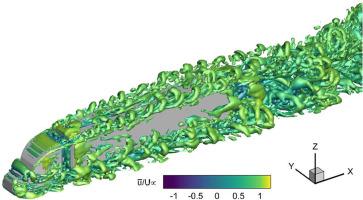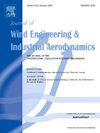Energy and frequency analysis in the wake of a heavy-duty truck model using large-eddy simulation
Abstract
In the current research, the turbulent flow field and wake characteristics around a realistic heavy duty truck model and at a practical Reynolds number Re = 2.6 × 106 (calculated using the free-stream velocity and the square root of the truck's frontal area) has been investigated using large eddy simulation based on an experimental wind-tunnel study conducted by National Research Council of Canada. The primary focus of this study is examining the budget terms and energy transfer from large-scale structures to the smaller scales. Major flow features and complex three-dimensional flow topology were investigated using qualitative and quantitative tools. Due to boundary layer separation, the downstream wake region was characterized by a quadrupole mean vortical structure. Evolution of budget-balance terms of turbulent kinetic energy (TKE) transport downstream of the truck model and the TKE distribution were thoroughly investigated revealing the influence of corner flow separation, side shear layer evolutions and rooftop boundary layer separation. The level of the budget terms was observed to be strongly influenced by the downstream propagation of the large-scale vortical structures. Furthermore, a frequency analysis was conducted on different components of integral aerodynamic force on the truck model and on several velocity and pressure probe data downstream of the truck model. The important Strouhal numbers indicating the correlation between flow separation, vortex shedding, and aerodynamic forces were identified.


 求助内容:
求助内容: 应助结果提醒方式:
应助结果提醒方式:


